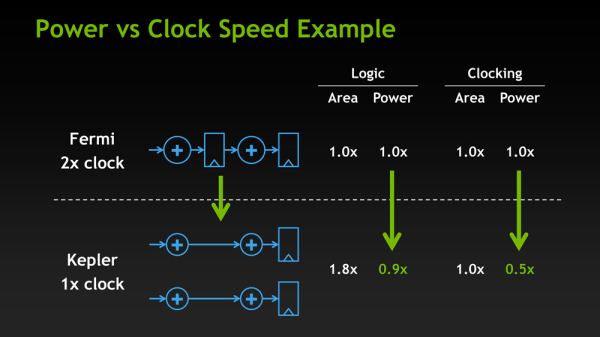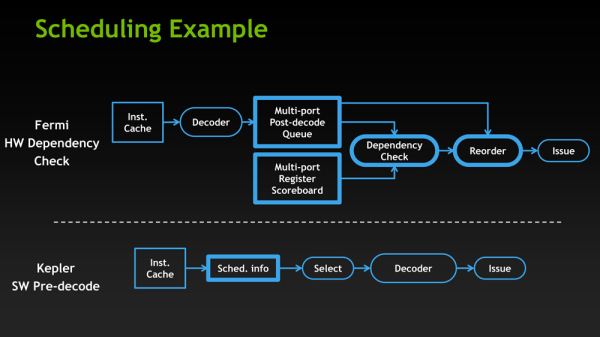NVIDIA GeForce GTX 680 Review: Retaking The Performance Crown
by Ryan Smith on March 22, 2012 9:00 AM ESTThe Kepler Architecture: Efficiency & Scheduling
So far we’ve covered how NVIDIA has improved upon Fermi for; now let’s talk about why.
Mentioned quickly in our introduction, NVIDIA’s big push with Kepler is efficiency. Of course Kepler needs to be faster (it always needs to be faster), but at the same time the market is making a gradual shift towards higher efficiency products. On the desktop side of matters GPUs have more or less reached their limits as far as total power consumption goes, while in the mobile space products such as Ultrabooks demand GPUs that can match the low power consumption and heat dissipation levels these devices were built around. And while strictly speaking NVIDIA’s GPUs haven’t been inefficient, AMD has held an edge on performance per mm2 for quite some time, so there’s clear room for improvement.
In keeping with that ideal, for Kepler NVIDIA has chosen to focus on ways they can improve Fermi’s efficiency. As NVIDIA's VP of GPU Engineering, Jonah Alben puts it, “[we’ve] already built it, now let's build it better.”
There are numerous small changes in Kepler that reflect that goal, but of course the biggest change there was the removal of the shader clock in favor of wider functional units in order to execute a whole warp over a single clock cycle. The rationale for which is actually rather straightforward: a shader clock made sense when clockspeeds were low and die space was at a premium, but now with increasingly small fabrication processes this has flipped. As we have become familiar with in the CPU space over the last decade, higher clockspeeds become increasingly expensive until you reach a point where they’re too expensive – a point where just distributing that clock takes a fair bit of power on its own, not to mention the difficulty and expense of building functional units that will operate at those speeds.
With Kepler the cost of having a shader clock has finally become too much, leading NVIDIA to make the shift to a single clock. By NVIDIA’s own numbers, Kepler’s design shift saves power even if NVIDIA has to operate functional units that are twice as large. 2 Kepler CUDA cores consume 90% of the power of a single Fermi CUDA core, while the reduction in power consumption for the clock itself is far more dramatic, with clock power consumption having been reduced by 50%.
Of course as NVIDIA’s own slide clearly points out, this is a true tradeoff. NVIDIA gains on power efficiency, but they lose on area efficiency as 2 Kepler CUDA cores take up more space than a single Fermi CUDA core even though the individual Kepler CUDA cores are smaller. So how did NVIDIA pay for their new die size penalty?
Obviously 28nm plays a significant part of that, but even then the reduction in feature size from moving to TSMC’s 28nm process is less than 50%; this isn’t enough to pack 1536 CUDA cores into less space than what previously held 384. As it turns out not only did NVIDIA need to work on power efficiency to make Kepler work, but they needed to work on area efficiency. There are a few small design choices that save space, such as using 8 SMXes instead of 16 smaller SMXes, but along with dropping the shader clock NVIDIA made one other change to improve both power and area efficiency: scheduling.
GF114, owing to its heritage as a compute GPU, had a rather complex scheduler. Fermi GPUs not only did basic scheduling in hardware such as register scoreboarding (keeping track of warps waiting on memory accesses and other long latency operations) and choosing the next warp from the pool to execute, but Fermi was also responsible for scheduling instructions within the warps themselves. While hardware scheduling of this nature is not difficult, it is relatively expensive on both a power and area efficiency basis as it requires implementing a complex hardware block to do dependency checking and prevent other types of data hazards. And since GK104 was to have 32 of these complex hardware schedulers, the scheduling system was reevaluated based on area and power efficiency, and eventually stripped down.
The end result is an interesting one, if only because by conventional standards it’s going in reverse. With GK104 NVIDIA is going back to static scheduling. Traditionally, processors have started with static scheduling and then moved to hardware scheduling as both software and hardware complexity has increased. Hardware instruction scheduling allows the processor to schedule instructions in the most efficient manner in real time as conditions permit, as opposed to strictly following the order of the code itself regardless of the code’s efficiency. This in turn improves the performance of the processor.
However based on their own internal research and simulations, in their search for efficiency NVIDIA found that hardware scheduling was consuming a fair bit of power and area for few benefits. In particular, since Kepler’s math pipeline has a fixed latency, hardware scheduling of the instruction inside of a warp was redundant since the compiler already knew the latency of each math instruction it issued. So NVIDIA has replaced Fermi’s complex scheduler with a far simpler scheduler that still uses scoreboarding and other methods for inter-warp scheduling, but moves the scheduling of instructions in a warp into NVIDIA’s compiler. In essence it’s a return to static scheduling.
Ultimately it remains to be seen just what the impact of this move will be. Hardware scheduling makes all the sense in the world for complex compute applications, which is a big reason why Fermi had hardware scheduling in the first place, and for that matter why AMD moved to hardware scheduling with GCN. At the same time however when it comes to graphics workloads even complex shader programs are simple relative to complex compute applications, so it’s not at all clear that this will have a significant impact on graphics performance, and indeed if it did have a significant impact on graphics performance we can’t imagine NVIDIA would go this way.
What is clear at this time though is that NVIDIA is pitching GTX 680 specifically for consumer graphics while downplaying compute, which says a lot right there. Given their call for efficiency and how some of Fermi’s compute capabilities were already stripped for GF114, this does read like an attempt to further strip compute capabilities from their consumer GPUs in order to boost efficiency. Amusingly, whereas AMD seems to have moved closer to Fermi with GCN by adding compute performance, NVIDIA seems to have moved closer to Cayman with Kepler by taking it away.
With that said, in discussing Kepler with NVIDIA’s Jonah Alben, one thing that was made clear is that NVIDIA does consider this the better way to go. They’re pleased with the performance and efficiency they’re getting out of software scheduling, going so far to say that had they known what they know now about software versus hardware scheduling, they would have done Fermi differently. But whether this only applies to consumer GPUs or if it will apply to Big Kepler too remains to be seen.












404 Comments
View All Comments
CeriseCogburn - Thursday, March 22, 2012 - link
Yes I don't see any former generations beating it. I think he has the hysteria downpat. ( the full GTX core rumored and confirmed is what's driving these people crazy, as well as the it will be $299 680 before AMD flopped out their $570 beaten card).So to an extent this will be the ongoing complaint - far be it from them to not demand the new card undercutting nearly every high end left on the shelves anywhere.
If that happened they could moan the 500+mm squared twice as fast monster chip is fail at $700 or $600 or $500 and unfair.
GTX570's were $350 days ago now they are $250
GTX580 is $359 at egg not $500
GTX460 is $110
---
There's a whole lot of focus on one top card from each company and a whole lot of ignoring the rest of reality, which it appears to me at least on Nvidia's behalf is a gigantic price slash no one has reported yet.
--
I don't understand why so silent, other than, massive bias, but there it is.
marc1000 - Thursday, March 22, 2012 - link
Did I miss it or it wasn't mentioned? What version of DX is this card running please? I ask this because AMD is at 11.1 and there is some hype on Windows 8 being 11.1 too. It's a minor upgrade from 11 but we must consider this on buying decisions too.marc1000 - Thursday, March 22, 2012 - link
yep, no word on DX version in more than 1 site. is this a DX10 card???? why nvidia doesn't let you talk about it?one thing AMD has always done is keep current with DX versions, and this caused them some performance penalties in almost every generation of cards. I remember when HD 5000 family launched that is was slower than HD 4000 in a "per core" fashion.
it seems like Nvidia is dropping on compatibility in order to win at performance. This is not too bad, but it is a little disapointing.
Klimax - Thursday, March 22, 2012 - link
According to czech site PcTuning (page http://pctuning.tyden.cz/hardware/graficke-karty/2... it is DirectX 11.1.marc1000 - Thursday, March 22, 2012 - link
is it? well, lets hope it really is. but why they are not marketing this?Ryan Smith - Thursday, March 22, 2012 - link
I can confirm it is DX11.1 (the page regarding that isn't up yet). NVIDIA isn't talking about DX11.1 much which is why you don't see it mentioned a lot. Given that the only major consumer feature will be S3D support (which benefits AMD more than NV), as you can imagine they're not exactly rushing to tell everyone.BurnItDwn - Thursday, March 22, 2012 - link
For 1080P and less, this card is really quite impressive, but it leaves a lot to be desired in the 2560x1600 category.I'd be curious to see triple headed performance figures ... (Nvidia can do something similar to Eyefinity right?)
Sabresiberian - Thursday, March 22, 2012 - link
Mmm for my purposes, the GTX 680 outperforms the Radeon 7970 enough to be a better buy (certainly if it actually costs less).Look at BF3 results and Skyrim results @2560x1600 (I actually run at 2560x1440, or on my other computer 1920x1200 at 85Hz) to see what is most important to me. Certainly, other games don't show the kind of performance increase you would want, but as in most hardware reviews, making the kind of statement you did without qualification means making an inaccurate one.
;)
CeriseCogburn - Thursday, March 22, 2012 - link
The the hardocp - in triple surround/eyefinity comp the 680 wins.It's a bad day for AMD and reviewers they lost that too
Now the reviewers will have to crank up 4 monitors and ruin a game and surf to see if they can squeeze out an amd win..
Spunjji - Sunday, March 25, 2012 - link
Can you stop posting, please? Your particular brand of repugnant obnoxiousness is making me nauseous.